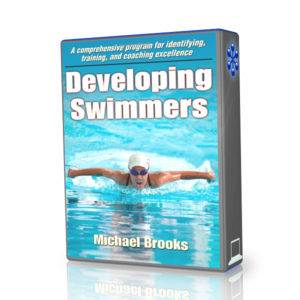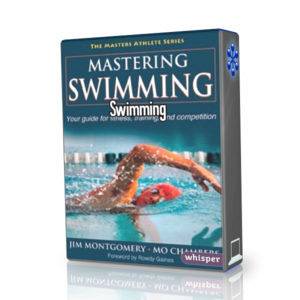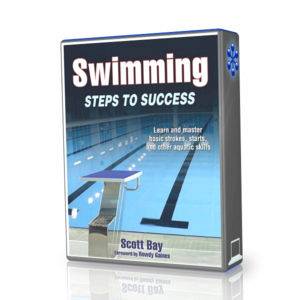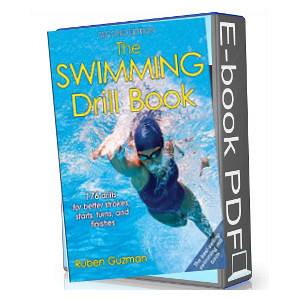The forward breathing style of the breaststroke makes the head position a factor in maintaining the forward line of the stroke. In addition, the timing of the breathing is crucial in reducing drag during the power phase of the stroke. Incorrectly timed, the breathing can break the forward motion of the stroke, but timed well, the breathing action can actually improve it. The goal of the following breathing drills is to learn the correct timing of the breaststroke breathing and to unify the head and body into a single action that benefits the stroke.
Inhale at the High Point
THE PURPOSE OF THIS DRILL
- Learning the correct timing of the inhale
- Breathing with the line of the stroke
- Feeling lift
HOW TO DO THIS DRILL
Step 1: Push off the wall preparing to swim breaststroke, arms extended. Achieve the downhill floating position. Begin your arm stroke, sweeping out, maintaining firm wrists and high elbows. Hold on to the water as you accelerate into the corners, maintaining a firm spine all the way through your neck. As your hands round the corners, preparing to sweep inward quickly, feel your body position change, and your upper body rise. Notice that without raising your chin, your mouth clears the water. Use this opportunity to inhale. As you recover and kick, notice that you regain the downhill position, and your face returns to the water.
Step 2: Do another stroke. Sweep your hands outward and into the corners. As your hands change directions at the corners, feel the lift produced for your head and upper body. Your breathing window occurs when your mouth clears the water, through the high point in the stroke, near the praying position. When you transition into the recovery, and back to the downhill position, allow your face to drop into the water with the rest of your upper body as you kick.
Step 3: Continue stroking. Allow your face to rise with each stroke cycle, as your stroke produces lift. Inhale at the high point in the stroke until your face returns to the water as you kick, with the forward line of the recovery.
Step 4: Continue practicing until you achieve your inhale as your face naturally rises to its high point. Then, allow your face to return to the water without creating any pause in the stroke.

DRILL FEEDBACK CHART
| Problem | Modification |
| I don't produce enough lift to get a breath. | Make sure that when approaching the corners you are accelerating through. Also, it is important at this point to draw your heels back, to achieve lift for your upper body. |
| I am inhaling before the corners. | Although you can catch a breath at this point in the stroke by raising your chin, doing so compromises the forward line of the stroke as your head tilts back, in effect, putting on the brakes. |
| My inhale is in the praying position. | Try accelerating out of the corners more to increase your natural lift. Beginning your inhale in the praying position encourages a drag-producing pause before the recovery. |
Med Hassan EL HAOUAT

Eyes on the Water
THE PURPOSE OF THIS DRILL
- Maintaining a stable head position
- Breathing with the line of the stroke
- Avoiding a nodding breathing style
HOW TO DO THIS DRILL
- Step 1 : - Push off the wall preparing to swim breaststroke. Achieve the downhill floating position, arms extended. Focus on maintaining a straight spine, from your hips through your neck. You should be looking at the bottom of the pool, not forward. Begin your arm stroke, sweeping out, and holding on to the water as you accelerate into the corners. As your hands move quickly round the corners, and you feel lift, allow your face to rise, focusing your eyes down at the water right in front of you the whole time. Inhale. Still maintaining your firm spine, return your face to the water as you recover and kick. Exhale.
- Step 2 : - Do another stroke. Inhale at the corners, looking at the water directly in front of you. As you finish your inhale, you should be able to see your hands move into the recovery. You should not be able to see the far end of the pool. As you kick, your face should drop down between your arms, and without changing your chin position, you should again be looking at the bottom of the pool as you exhale.
- Step 3 : - Continue stroking, maintaining a straight spine line through your neck. Avoid any nodding action as you breathe with each stroke. As your face rises to inhale, keep your eyes on the water right in front of you. Watch your hands move into the recovery. Regain your downhill position as you kick, letting your face return to the water without any independent head movement. Exhale and glide, looking at the bottom of the pool.
- Step 4 : - Practice to the far end of the pool, maintaining a stable head position, looking down at the water during breathing, and at the bottom of the pool during the glide.

DRILL FEEDBACK CHART
| Problem | Modification |
| I can't glide downhill unless I lower my chin during the recovery. | If you chin starts in a low position, you would not have to lower it during the recovery. Use a quick arm stroke to achieve lift to breathe while looking at water. Then, drop your chest down and forward, as you move into the recovery. Your shoulder shrug will also help you transition to the downhill position. This way your head and body will work together to maintain the forward line of the stroke. |
| I can't tell where I am in the pool. | Look at the line on the bottom of the pool. There should be a T as you are approaching the wall. Then you will be able to use your peripheral vision to see the wall while maintaining a beneficial stable head position. |
| My head goes back into the water before my hands recover. | You might be inhaling too early in the stroke. Or your hands could be moving too slowly. However, this shows you are looking at the water! Inhale only when you feel lift at the corners, and sweep quickly inward, then without a pause, shoot into the recovery. As your arms form an arrow beyond your face, there is a perfect space for your head to return to the water between your arms as you kick. |
Tennis Ball Drill
THE PURPOSE OF THIS DRILL
- Maintaining a stable head position
- Breathing with the lift of the stroke
- Achieving lift by dropping the hips
HOW TO DO THIS DRILL
- Step 1 : - Place a tennis ball under your chin and hold it there, maintaining a straight spine all the way up through your neck. This will require you to adjust the position of the tennis ball out from your throat, holding on to it with the point of your chin. Check in a mirror to insure your spine-line is not compromised.
- Step 2 : - Push off the wall preparing to swim breaststroke, holding the tennis ball with your chin. Achieve the downhill floating position, arms extended. In order to avoid dropping the tennis ball, look at the bottom of the pool. Begin your arm stroke, sweeping out, and accelerate into the corners. As your hands quickly round the corners and you achieve lift, inhale without dropping the tennis ball. Return your face to the water as you recover and kick. Exhale.
- Step 3 : - Do another stroke. Accelerate your arm stroke to achieve lift. Maintaining a firm hip position, draw your heels back toward your buttocks, and breathe when your head is naturally at the highest point in the stroke. Hold on to the tennis ball and inhale from the corners through the praying position. As you recover and kick, press your chest down, allowing your face to return to the water without dropping the tennis ball.
- Step 4 : - Once you have suc- ceeded in doing a stroke without dropping the tennis ball, try three strokes in a row. Maintain stable hips and a straight spine-line through your neck. Use an accelerating arm stroke as you draw your heels back to achieve lift to inhale. Regain your downhill position as your recover and kick, looking down at the water and pressing your chest down for the glide.
- Step 5 : - Repeat this drill over several practices, until you are able to hold on to the tennis ball for an entire length of the pool.

DRILL FEEDBACK CHART
| Problem | Modification |
| I don't get enough lift to breathe. | Make sure you are using a productive sculling action, outward then inward, accelerating your hands throughout the stroke. |
| I drop the ball at the corners. | This probably means you are raising your chin at this point. Instead, look down and accelerate your insweep faster to clear the water for the inhale. |
| I drop the ball during recovery. | You are probably looking forward, not down during recovery. Use your chest to achieve your glide position, rather than your head. Making this change will improve your glide productivity, because you will have less frontal resistance. |







